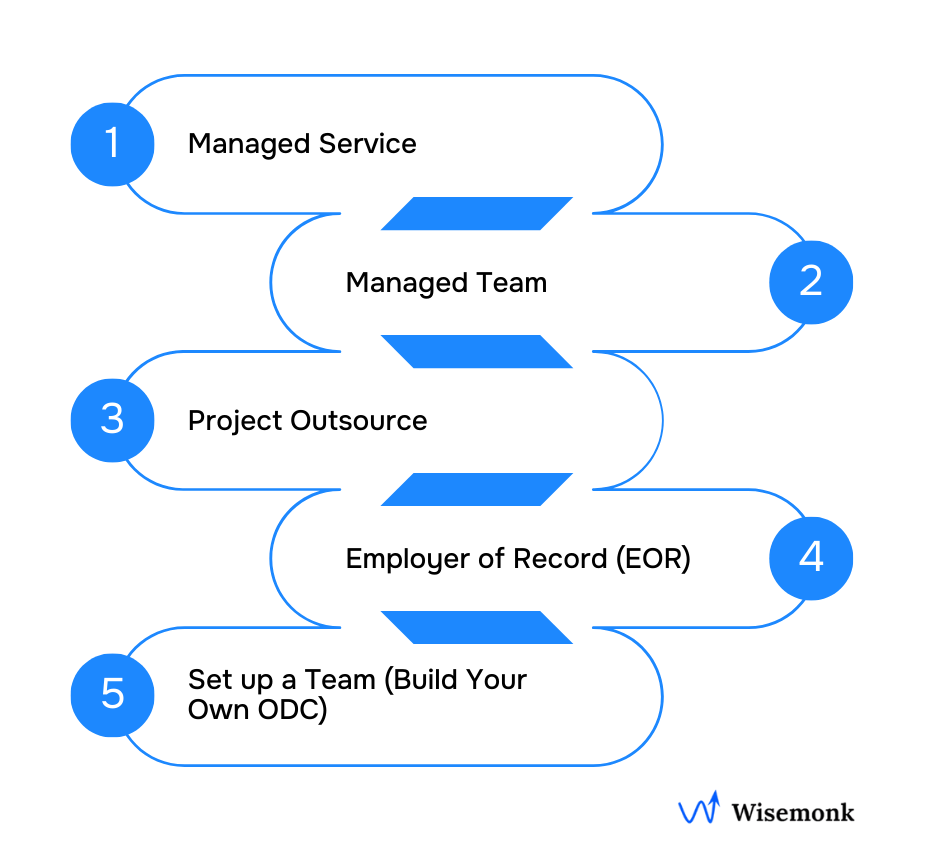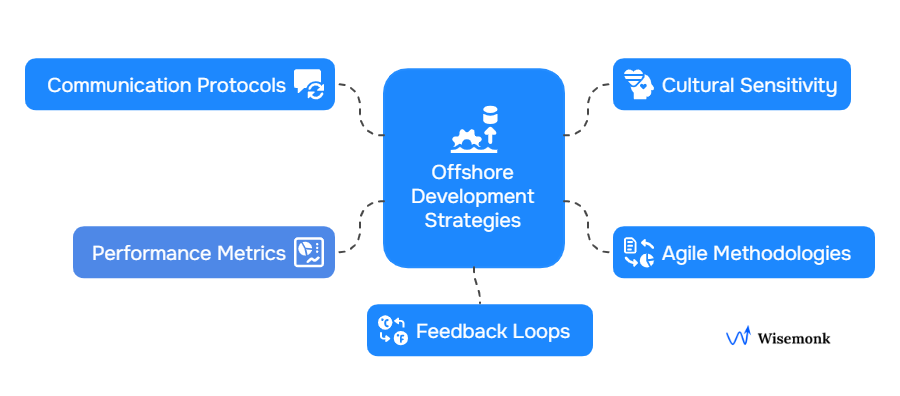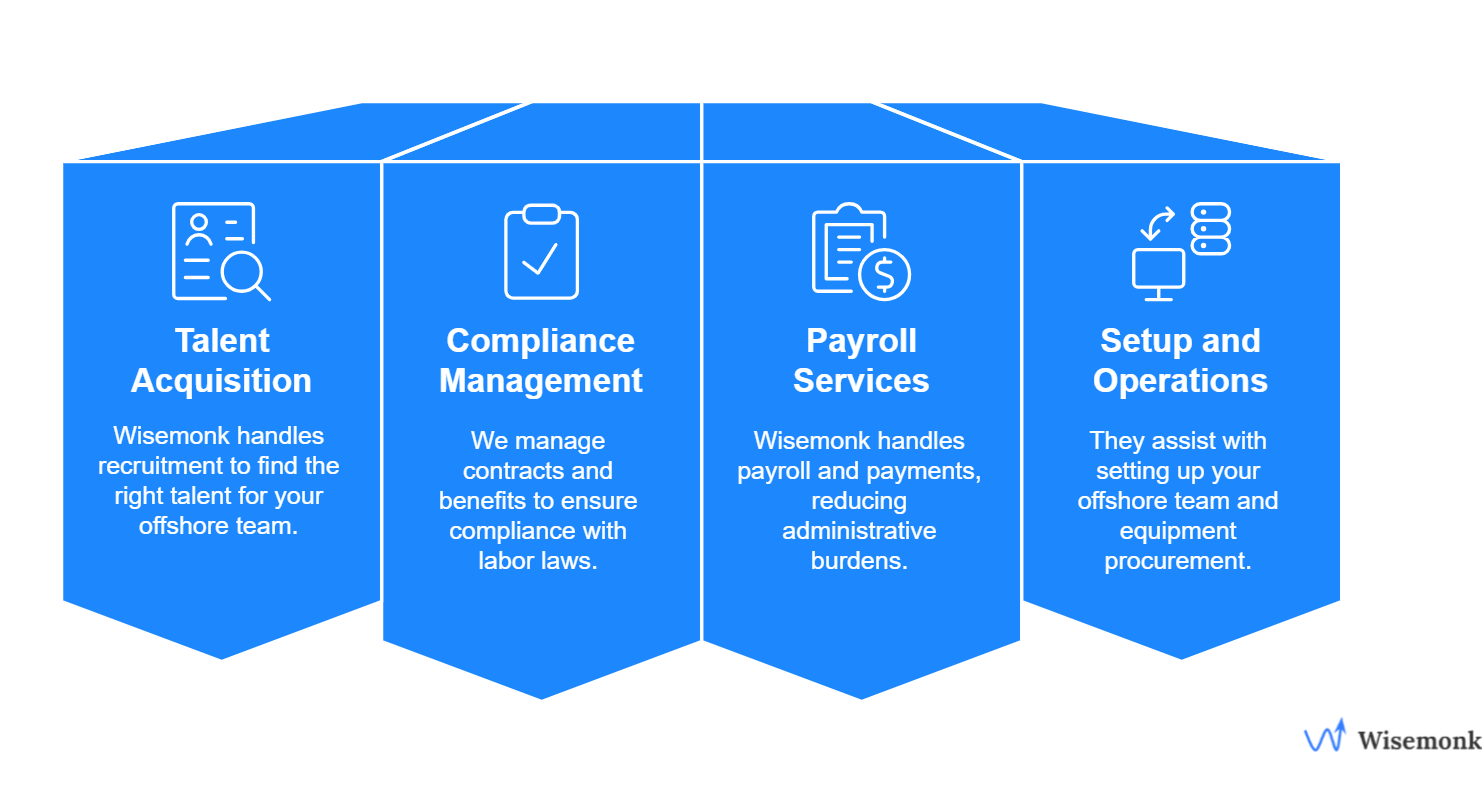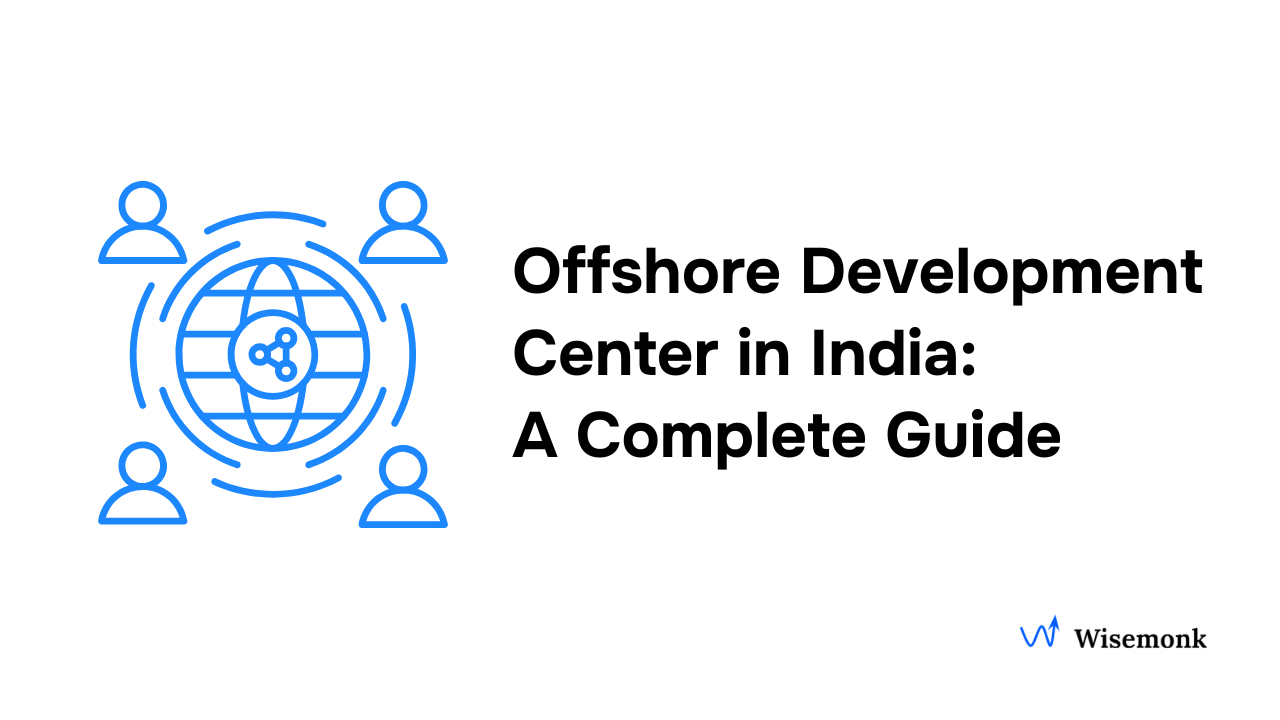- An Offshore Development Center (ODC) is a dedicated team of software developers in another country, offering clients more control and integration than traditional outsourcing.
- India is the top ODC destination due to its vast talent pool of 3+ million IT professionals, 70% cost savings, 24/7 development cycles, and major tech hubs like Bangalore, Hyderabad, and Pune.
- Five ODC models available: Managed Service (vendor-controlled), Managed Team (dedicated team with admin support), Project Outsource (specific tasks), Employer of Record (hire without local entity), and Build Your Own (full ownership).
- Setting up ODC requires defining goals, choosing a location/model, ensuring legal compliance, recruiting talent, establishing infrastructure, and implementing communication protocols.
Need help with setting up an Offshore Development Center in India? Contact Us Today!
Discover how Wisemonk creates impactful and reliable content.
Thinking about an offshore development center in India? If you’re facing high costs or struggling to scale your tech team, this article is for you, explaining the benefits, key steps to set up an offshore development center, and expert tips to make offshore expansion smooth and successful. Get ready for clear, concise guidance on building your ideal offshore team!
What is an Offshore Development Center (ODC)?[toc=What is an ODC]
An Offshore Development Center (ODC) is a dedicated remote facility in another country, such as India, where a business builds its own development team to handle software development and critical operations. It works like a virtual extension of your in house team but at a lower operational expense and with access to a global talent pool.
Key Features of an ODC in India:
- Dedicated team: Offshore team members work only on your projects, aligning with your company’s culture and long term business goals.
- Seamless integration: Teams stay connected through project management software, communication tools, and clear communication channels.
- Specialized expertise: Offshore development services provide niche skills like AI, cloud, cybersecurity, and other emerging technologies.
- Operational efficiency: Offshore development models deliver significant cost savings, with studies showing up to 60 percent reduction in development costs (Deloitte, 2023).
- Robust security measures: Offshore development companies maintain strong data security and protect intellectual property rights.
What are the key benefits of an offshore development center in India?[toc=Key Benefits of ODC]
An offshore development center in India offers global businesses a blend of cost efficiency, specialized skills, and seamless collaboration. India has become the preferred hub for building offshore teams because it provides both scale and quality in software development.
Key Benefits of an ODC in India:
- Cost Effectiveness: Companies can realize reductions (as much as 60%) in operational and staffing expenses relative to employing personnel, in Western nations.
- Availability of Extensive Talent Resource: India graduates millions of engineers each year offering access to a reservoir of skilled experts proficient in various advanced technologies such, as AI, ML, cloud computing and DevOps.
- Scalability and Adaptability: ODCs enable organizations to quickly adjust their team size according to project needs, without the burden of long-term recruitment and infrastructure maintenance.
- Time Zone Benefit: The variation in time zones allows for a 24/7 "follow-the-sun" development process ensuring progress carries on while local teams are, off duty speeding up project delivery.
- Concentrate on Primary Operations: The ODC service provider usually manages tasks, like hiring, infrastructure establishment, compliance and human resources enabling the client to prioritize primary business goals.
- Intellectual Property (IP) Protection: Reputable ODC providers implement robust security measures, including NDAs, data encryption, and compliance with international standards (like ISO 27001), to safeguard sensitive information.
How is an ODC different from traditional outsourcing?[toc=Offshoring vs. Outsourcing]
An Offshore Development Center (ODC) is like having your own dedicated offshore team that works exclusively for your business, while traditional outsourcing usually involves hiring a vendor to deliver a specific project.
The key difference is ownership and control, ODCs act as an extension of your in house team, whereas outsourcing is more of a vendor-client arrangement:
From our work with global companies, we’ve seen that ODCs provide more stability, ownership, and long-term value, while outsourcing is best suited for one-time or non-critical projects. Businesses aiming for business growth and specialized expertise often choose the ODC model to gain a competitive edge.
If you want to explore more about outsourcing, check out our complete guide on "Outsourcing Software Development to India".
Where are the Top ODC Locations in India?[toc=Top ODC Locations]
India’s leading tech hubs provide a vibrant ecosystem for establishing an offshore development center. Over the years, we’ve helped companies set up dedicated offshore teams in cities known for their deep talent pool, operational efficiency, and specialized expertise in software development.
Major ODC Locations in India:
- Bangalore: Widely recognized as the IT capital, Bangalore offers a vast talent pool, robust infrastructure, and easy access to emerging technologies. Offshore development centers here excel in handling complex business operations for global clients.
- Hyderabad: With rapid growth in its tech scene and competitive operational expenses, Hyderabad is an excellent choice for dedicated teams focused on software development, data security, and quality assurance.
- Pune: Known for affordability and its skilled workforce, Pune’s development centers support seamless integration, especially for companies seeking cost savings and smooth project management.
- Chennai: Strong in engineering and technical talent, Chennai stands out for specialized skills and a culture attuned to high-quality software development services.
- Gurgaon & Noida (NCR): Proximity to the national capital, strong project management software adoption, and an active startup ecosystem make Gurgaon and Noida popular for offshore development center services requiring agility and scalability.
Having guided several organizations through location selection, we’ve seen that choosing the right city in India can have a significant impact on reducing development costs, accessing core competencies, and ensuring seamless collaboration between your in-house team and offshore team in India.
What ODC models can you use in India?[toc=Engagement Models]
An offshore development center in India can be structured in different ways depending on how much control you want, your budget, and the complexity of your business operations. These models give companies flexibility to scale, reduce costs, and access specialized skills.
From our experience helping several global businesses set up an offshore development center, here are the most common models companies choose in India:

1. Managed Service
The offshore development partner handles everything including infrastructure, hiring, and offshore software development services. This ensures cost efficiency and smooth delivery, though you have less control over day-to-day management.
2. Managed Team
You get a dedicated team of offshore developers who work only for your company, while the offshore partner manages payroll, compliance, and office space. This model allows seamless integration with your in house team and supports long term project development.
3. Project Outsource
Best suited for short-term or non core projects, this model involves outsourcing a specific task to an offshore development company. It helps reduce costs quickly but may create cultural and communication barriers if used for critical business operations.
4. Employer of Record (EOR)
With an EOR, you can hire offshore team members in India legally without establishing a local entity. The EOR becomes the legal employer managing payroll, benefits, and compliance while you focus on managing project development. It is ideal for testing new markets or scaling with reduced operational expenses.
5. Set up a Team (Build Your Own ODC)
This is the full-scale model where you establish your own offshore development center in India with office space, project managers, and a complete development team. It gives maximum control and robust security measures but requires higher upfront investment and strong management systems.
"Many global companies start with an EOR or Managed Team model to reduce risks and operational expenses, then move to a full-scale ODC once they are ready for long term growth in India."
— Aditya Nagpal
Founder & CEO, Wisemonk
LinkedIn Profile →
How to set up an offshore development center in India?[toc=How to Set Up ODC]
Setting up an offshore development center in India can be a game changer for scaling your software development capability while harnessing a large, specialized talent pool and achieving cost efficiency.
Based on our extensive hands-on experience guiding several companies through this process, here’s a concise, step-by-step guide, reflecting proven practices and organizational trust:

Step 1: Define Goals and Scope
- Clearly identify your business goals, whether it’s cost reduction, tapping specialized skills, accessing the global talent pool, or accelerating project timelines.
- Outline the exact software development services your ODC will handle, and set key performance indicators to track progress.
- In our experience, well-defined objectives create a unified vision and efficient decision-making.
Step 2: Choose Location and Engagement Model
- Select the Indian city (Bangalore, Hyderabad, Pune, Chennai, Gurgaon/Noida) that best fits your operational efficiency needs and team building goals.
- Decide on an engagement model: set up your own entity or partner with a trusted offshore development company for seamless integration and faster ramp-up.
- We’ve seen that aligning location with technical requirements enhances both cost savings and specialized expertise.
Step 3: Legal, Tax, and Compliance Structures
- Register your legal entity in India (Private Limited Company, LLP, or Branch Office).
- Ensure compliance with Indian labor laws (Provident Fund, Employee State Insurance, Shops and Establishments Act), tax regulations, and robust data security policies.
- Protect intellectual property with strong contracts, NDAs, and regular legal audits. Engaging local legal and tax advisors will streamline this phase.
Step 4: Recruit the Right Talent
- Build your dedicated team by tapping the large Indian talent pool, recruit software developers, project managers, and quality assurance experts with relevant experience for your development center.
- Conduct interviews to assess technical and cultural alignment. Be clear about core competencies and business goals for sustainable team building.
If you need help with recruitment in India, check out our guide on "Top 10 Recruitment Agencies in India for 2025".
Step 5: Set Up IT Infrastructure and Office Space
- Secure office space fitted with reliable internet, secure networks, and modern technology stack for project development and smooth communication.
- Implement robust security measures (physical and digital) to safeguard critical business operations and sensitive data.
Step 6: Begin Operations and Integration
- Establish project management software and clear communication channels to foster seamless collaboration between offshore teams and your in-house team.
- Onboard team members with a focus on your company’s culture and continuous training. Integrate your offshore development partner into business operations using standard project management tools, daily scrums, and quality assurance protocols.
Step 7: Monitor, Improve, and Scale
- Track progress using transparent performance indicators and feedback. Regularly review operations, address cultural and communication barriers, and invest in ongoing training.
- As your business grows, leverage the scalable, dedicated offshore development center model to expand your team in India and gain a sustainable competitive edge.
Pro Tip: Start with a small dedicated team for 2 sprints, validate KPIs, then scale in controlled waves. This keeps development costs predictable, maintains quality, and limits risk while you build operational efficiency.
What should you consider when choosing an ODC in India?[toc=Key Considerations]
Selecting the right offshore development center (ODC) in India is a crucial decision that can impact your software development quality, operational efficiency, and long-term business growth.
Based on our extensive experience advising global organizations, here are the key factors to evaluate:
- Talent Availability: India offers a vast talent pool, but cities differ in the depth and diversity of specialized skills. Analyze the local market to ensure your ODC has access to the technical expertise needed for your projects.
- Infrastructure Quality: Prioritize locations with state-of-the-art IT parks, reliable power, robust digital connectivity, and proximity to essential business services. Better infrastructure enables smooth collaboration and scalability.
- Cost of Living and Operations: Operating expenses, including salaries, office space, and support services, can vary between Tier 1 and Tier 2 cities. Consider both cost savings and readiness of local amenities to strike the right balance.
- Government Policies and Incentives: Research local and national programs such as tax breaks, SEZ benefits, streamlined registration, and export-friendly regulations that can reduce costs and ease setup and operations.
- Data and IP Protection Laws: India’s Digital Personal Data Protection Act (DPDP Act, 2023) closely aligns with global standards like GDPR. Ensure your engagement model and contracts provide comprehensive coverage for intellectual property and data privacy, with strong NDAs and compliance frameworks.
- Time Zone Alignment: Time zone overlap with your core markets can streamline communication and agile development. Evaluate cities where working hours match or complement your global operations to maximize productivity.
- Cultural & Communication Compatibility: Assess language proficiency and cultural alignment. Effective integration is easier in cities with cosmopolitan work cultures and high English proficiency.
How is security handled in ODCs?[toc=Security Measures]
Protecting sensitive data and maintaining operational integrity are top priorities for any offshore development center in India.
Based on our experience guiding clients through ODC setup and management, well-designed security protocols not only build trust but also ensure business continuity and compliance.
Core Security Measures in ODCs:
- VPN and Firewall Usage: All network traffic typically flows through enterprise-grade VPNs and monitored firewalls, creating a secure perimeter for remote development teams. This shields business operations from unauthorized access and external threats.
- Secure Coding Standards: Offshore teams adhere to proven secure coding practices, incorporating regular code reviews and vulnerability assessments to safeguard software development from cyber risks.
- NDAs and IP Protection Clauses: Every offshore development center enforces strict nondisclosure agreements and includes robust intellectual property clauses in contracts. This guarantees that your proprietary technology and sensitive information remain protected.
- Physical Security and Access Control: ODC office spaces feature controlled entry, surveillance, and restricted zones to prevent physical breaches. Only authorized team members can access critical business systems or data.
- Regular Audits and Compliance Checks: Frequent internal and external audits, alongside compliance with standards like ISO 27001 or the Indian DPDP Act, ensure ongoing data security and risk management within the offshore development center.
How to manage your offshore team in India?[toc=Best Practices]
Successfully managing your offshore development center in India requires a blend of clear protocols, cultural awareness, agile processes, and transparent performance tracking.
Having supported global businesses through every stage of offshore team integration, we've seen firsthand how the right approach boosts operational efficiency and drives lasting results:

1. Establish Clear Communication Protocols
Set explicit guidelines for communication, detailing frequency, preferred channels (like Slack, Teams, or Zoom), and documentation practices. Clear protocols help avoid misunderstandings, reduce time zone friction, and ensure everyone is aligned on project milestones and responsibilities. Use project management software (such as Jira or Trello) to streamline information flow and track progress.
2. Invest in Cultural Sensitivity Training
To overcome cultural and communication barriers, provide cross-cultural training for both in-house and offshore team members. Understanding work styles, holiday calendars, and communication nuances common in India fosters respect and helps build a collaborative, unified offshore team. Encourage open feedback and make space for diverse perspectives in decision-making.
3. Embed Agile Methodologies
Adopt agile frameworks, like Scrum or Kanban, for more iterative project development, frequent feedback loops, and adaptability. Agile models are especially effective for distributed offshore teams, ensuring that everyone responds quickly to feedback and changing requirements, while maintaining high quality and operational efficiency.
4. Define Performance Metrics and KPIs
Monitor productivity and quality by establishing clear key performance indicators (KPIs) specific to offshore software development services. Track metrics such as defect density, velocity, on-time delivery, customer satisfaction, and code review effectiveness, they provide objective insight into progress and help guide improvements. Frequent performance reviews and data-driven discussions keep everyone accountable and motivated.
5. Create Regular Feedback Loops and Team Visits
Encourage regular video check-ins, daily standups, and retrospective meetings to maintain strong feedback cycles and quickly resolve challenges. When possible, organize periodic visits (physical or virtual) between onshore and offshore team members, these reinforce relationships, increase trust, and strengthen alignment with your company's culture and business goals.
What mistakes should you avoid with offshore development?[toc=Mistakes to Avoid]
Choosing the right approach for offshore development services in India can transform your software capability, but there are several common pitfalls that can derail even the best-intentioned projects.
Based on our extensive work supporting global clients and reviewing industry best practices, here are the key mistakes to avoid:
- Choosing Based on Cost Alone: Focusing only on hourly rates or the cheapest provider often leads to sacrificing quality, skills, or long-term reliability. It’s essential to assess cost-effectiveness and value, such as process maturity, previous experience, and track record, rather than price tags alone.
- Poor Onboarding and Integration: Skimping on onboarding or treating your offshore development center as just a remote vendor can cause alignment issues. A well-structured onboarding process, strong team-building, and cultural integration help new team members connect with your company’s goals and working style.
- Ignoring Time Zone Coordination: Overlooking time zone differences creates delays, missed communications, and project bottlenecks. Successful offshore development relies on planned overlapping work hours, smart scheduling, and clear protocols for seamless collaboration and timely decisions.
- Lack of Clear Ownership and Accountability: Without well-defined roles, responsibilities, and performance indicators, your offshore team may lose focus and productivity. Assign project managers or liaisons on both sides and set measurable goals to foster accountability and clarity.
- Overlooking Legal and Compliance Risks: Failing to understand Indian labor laws, tax rules, or data protection standards can pose real risks, from compliance failures to intellectual property issues. Ensure contracts, NDAs, audits, and processes are robust and aligned with global and local regulations.
Avoiding these mistakes will help your offshore development team in India operate efficiently, deliver consistent value, and become a true partner in your long-term business growth.
Wisemonk: Your Trusted Partner for Offshore Development Center in India[toc=How Wisemonk helps]
Wisemonk is one of India’s leading Employer of Record (EOR) partners, trusted by 500+ international companies that want to build high-performing Offshore Development Centers in India without drowning in paperwork, compliance headaches, or local bureaucracy. Wisemonk streamlines hiring, payroll, and HR operations so global teams can tap into India’s world-class talent without regulatory friction. Wisemonk brings deep local expertise, strong talent networks, and reliable on-ground support to keep offshore teams running smoothly.

Wisemonk's Services for Offshore Development Center in India:
- Talent Acquisition: Wisemonk handles recruitment, ensuring you find the right talent for your offshore team.
- Compliance Management: We manage employment contracts, statutory benefits, and terminations, ensuring compliance with Indian labor laws.
- Payroll and Contractor Management: Wisemonk handles all payroll and payment services, reducing administrative burdens.
- Setup and Operations: We assist with setting up your offshore team, including equipment procurement and management.
Client review/feedback:
“Wisemonk has successfully hired high-quality candidates, which has impressed the client. The team is responsive to the client's requests and changes via Slack. The team also collaborates through a hiring tracker in Google Sheets. Wisemonk communicates via email and virtual meetings.”
— Dan Sampson
VP of Engineering, Cobu
Read the full review on Clutch →
In addition to these services, Wisemonk also provides background verification, tax optimization, employee benefits, and GCC setup solutions, making them a one-stop shop for all your offshore needs in India.
Whether you're spinning up a small engineering pod or scaling a full ODC, Wisemonk removes the operational friction so you can tap into India’s world-class talent pool with confidence.
Book a Call Today to explore how Wisemonk can support your offshore operations.





%20(5).webp)

